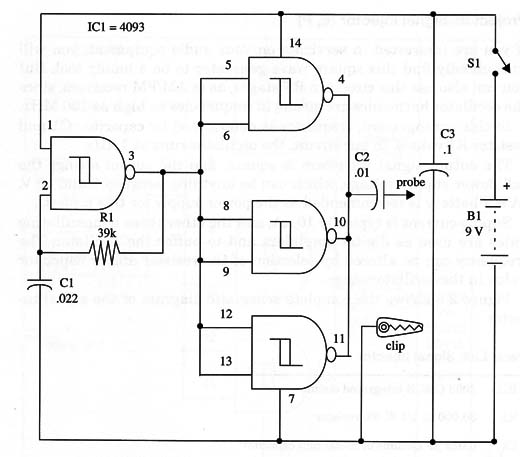If you are interested in servicing on your audio equipment, you will undoubtedly find this square wave generator to be a handy tool. But you can also use this circuit in RF stages, as in AM/FM receivers, since the oscillator harmonics are strong in frequencies as high as 100 MHz.
In this arrangement, frequency is determined by capacitor Cl and resistor R1 values. In our circuit, the oscillator runs at 1 kHz.
The output signal waveform is square, and the output swings the full power supply voltage, which can be anything between 6 and 15 V. (A 9 V battery is recommended as the power supply for this project).
Supply current is typically 10 µA, and the other three nonoscillating gates are used as digital amplifiers and to buffer the oscillator. The frequency can be altered by selection of the resistor and/or capacitor value in the oscillator stage.
Figure 1 shows the complete schematic diagram of the signal injector.

A signal injector is used from the back to the front of an audio (or RF) circuit.
For instance, to use the signal injector with an AM receiver apply the signal from the probe at the base of the output transistor. If that stage and everything after it operates correctly, the signal will be heard in the speaker. If the output stage proves to be OK, move back to the base of the driver transistor. The output signal will be higher if everything is working.
Then apply the signal progressively toward the front of the circuit by injecting it at the volume control, detector stage, IF stages, and the mixer.
The circuit can be housed in a small plastic box and connected to the external circuits through a probe and an alligator clip.
IC1 - 4093 CMOS integrated circuit
R1 - 39,000 9, 1/4 W, 5% resistor
C1 - 0.022 µF ceramic or metal film capacitor
C2 - 0.01 µF ceramic or metal film capacitor
C3 - 0.1 µF ceramic or metal film capacitor
B1 - 9V battery and holder
S1 - SPST switch




